Spectroscopic Detection of Glyphosate in Water Assisted by Laser-Ablated Silver Nanoparticles
Abstract
:1. Introduction
2. Materials and Methods
2.1. Silver Nanoparticle Production
2.2. Analyte Samples
2.3. UV-Vis Measurements
2.4. Raman Measurements
3. Results and Discussion
3.1. Silver Nanoparticles with Glyphosate
3.2. Silver Nanoparticles with Interferents and Comercial Formulations
4. Conclusions
Acknowledgments
Author Contributions
Conflicts of Interest
References
- Malik, J.; Barry, G.; Kishore, G. The herbicide glyphosate. Biofactor 1989, 2, 17–25. [Google Scholar]
- Cox, C. Glyphosate, part 1: Toxicology. J. Pestic. Reform 1995, 15, 14–20. [Google Scholar]
- Santadino, M.; Coviella, C.; Momo, F. Glyphosate sublethal effects on the population dynamics of the earthworm eisenia fetida (Savigny, 1826). Water Air Soil Pollut. 2014, 225, 2207. [Google Scholar] [CrossRef]
- Hallas, L.E.; Adams, W.J.; Heitkamp, M.A. Glyphosate degradation by immobilized bacteria: Field studies with industrial wastewater effluent. Appl. Environ. Microbiol. 1992, 58, 1215–1219. [Google Scholar] [PubMed]
- Ascolani Yael, J.; Fuhr, J.D.; Bocan, G.A.; Millone, A.D.; Tognalli, N.; Afonso, M.S.; Martiarena, M.L. Abiotic degradation of glyphosate into aminomethylphosphonic acid in the presence of metals. J. Agric. Food Chem. 2014, 62, 9651–9656. [Google Scholar] [CrossRef] [PubMed]
- Khrolenko, M.V.; Wieczorek, P.P. Determination of glyphosate and its metabolite aminomethylphosphonic acid in fruit juices using supported-liquid membrane preconcentration method with high-performance liquid chromatography and UV detection after derivatization with p-toluenesulphonyl chloride. J. Chromatogr. A 2005, 1093, 111–117. [Google Scholar] [PubMed]
- IARC. Monographs on the evaluation of carcinogenic risks to humans. Int. Agency Res. Cancer 2012, 100F, 249–294. [Google Scholar]
- Jayasumana, C.; Gunatilake, S.; Senanayake, P. Glyphosate, hard water and nephrotoxic metals: Are they the culprits behind the epidemic of chronic kidney disease of unknown etiology in Sri Lanka? Int. J. Environ. Res. Public Health 2014, 11, 2125–2147. [Google Scholar] [CrossRef] [PubMed]
- Ministério da Saúde. Portaria 2914/2011—Procedimentos de Controle e de Vigilância da Qualidade da Água para Consumo Humano e seu Padrão de Potabilidade; Ministério da Saúde: Brasilia, Brasil, 2011. (In Portuguese)
- Conselho Nacional do Meio Ambiente. Resolução 357/2005—Dispõe Sobre a Classificação dos Corpos de Água e Diretrizes Ambientais Para o seu Enquadramento, bem como Estabelece as Condições e Padrões de Laçamento de Efluentes, e da Outras Providências; Conselho Nacional do Meio Ambiente: Brasilia, Brasil, 2011. (In Portuguese)
- U.S. Environmental Protection Agency. Method 547 Determination of Glyphosate in Drinking Water by Direct Aqueous-Injection HPLC, Post-Column Derivatization, and Fluorescence Detection; Environmental Protection Agency: Cincinnati, OH, USA, 1990.
- Meyer, M.T.; Loftin, K.A.; Lee, E.A.; Hinshaw, G.H.; Dietze, J.E. Determination of Glyphosate, its Degradation Product Aminomethylphosphonic Acid, and Glufosinate, in Water by Isotope Dilution and Online Solid-Phase Extraction and Liquid Chromatography/Tandem Mass Spectrometry; U.S. Geological Survey: Lawrence, KS, USA, 2009.
- Sanchís, J.; Kantiani, L.; Llorca, M.; Rubio, F.; Ginebreda, A.; Fraile, J.; Garrido, T.; Farré, M. Determination of glyphosate in groundwater samples using an ultrasensitive immunoassay and confirmation by on-line solid-phase extraction followed by liquid chromatography coupled to tandem mass spectrometry. Anal. Bioanal. Chem. 2012, 402, 2335–2345. [Google Scholar] [CrossRef] [PubMed]
- Jan, M.R.; Shah, J.; Muhammad, M.; Ara, B. Glyphosate herbicide residue determination in samples of environmental importance using spectrophotometric method. J. Hazard. Mater. 2009, 169, 742–745. [Google Scholar] [CrossRef] [PubMed]
- Zheng, J.; Zhang, H.; Qu, J.; Zhu, Q.; Chen, X. Visual detection of glyphosate in environmental water samples using cysteamine-stabilized gold nanoparticles as colorimetric probe. Anal. Methods 2013, 5, 917–924. [Google Scholar] [CrossRef]
- Wei, H.; Abtahi, S.M.H.; Vikesland, P.J. Plasmonic colorimetric and SERS sensors for environmental analysis. Environ. Sci. Nano 2015, 2, 120–135. [Google Scholar] [CrossRef]
- Laliwala, S.K.; Mehta, V.N.; Rohit, J.V.; Kailasa, S.K. Citrate-modified silver nanoparticles as a colorimetric probe for simultaneous detection of four triptan-family drugs. Sens. Actuators B Chem. 2014, 197, 254–263. [Google Scholar] [CrossRef]
- Patel, G.M.; Rohit, J.V.; Singhal, R.K.; Kailasa, S.K. Recognition of carbendazim fungicide in environmental samples by using 4-aminobenzenethiol functionalized silver nanoparticles as a colorimetric sensor. Sens. Actuators B Chem. 2015, 206, 684–691. [Google Scholar] [CrossRef]
- Vilela, D.; González, M.C.; Escarpa, A. Sensing colorimetric approaches based on gold and silver nanoparticles aggregation: Chemical creativity behind the assay. A review. Anal. Chim. Acta 2012, 751, 24–43. [Google Scholar] [CrossRef] [PubMed]
- Baker, G.A.; Moore, D.S. Progress in plasmonic engineering of surface-enhanced Raman-scattering substrates toward ultra-trace analysis. Anal. Bioanal. Chem. 2005, 382, 1751–1770. [Google Scholar] [CrossRef] [PubMed]
- Sharma, H.S.S.; Carmichael, E.; McCall, D. Fabrication of SERS substrate for the detection of rhodamine 6G, glyphosate, melamine and salicylic acid. Vib. Spectrosc. 2016, 83, 159–169. [Google Scholar] [CrossRef]
- Jiang, X.; Yang, M.; Meng, Y.; Jiang, W.; Zhan, J. Cysteamine-modified silver nanoparticle aggregates for quantitative sers sensing of pentachlorophenol with a portable Raman spectrometer. ACS Appl. Mater. Interfaces 2013, 5, 6902–6908. [Google Scholar] [CrossRef] [PubMed]
- McNay, G.; Eustace, D.; Smith, W.E.; Faulds, K.; Graham, D. Surface-enhanced Raman scattering (SERS) and surface-enhanced resonance Raman scattering (SERRS): A review of applications. Appl. Spectrosc. 2011, 65, 825–837. [Google Scholar] [CrossRef] [PubMed]
- Saute, B.; Narayanan, R. Solution-based direct readout surface enhanced Raman spectroscopic (SERS) detection of ultra-low levels of thiram with dogbone shaped gold nanoparticles. Analyst 2011, 136, 527–532. [Google Scholar] [CrossRef] [PubMed]
- Potara, M.; Gabudean, A.M.; Astilean, S. Solution-phase, dual LSPR-SERS plasmonic sensors of high sensitivity and stability based on chitosan-coated anisotropic silver nanoparticles. J. Mater. Chem. 2011, 21, 3625. [Google Scholar] [CrossRef]
- Torul, H.; Boyaci, İ.H.; Tamer, U. Attomole detection of glyphosate by surface enhanced Raman spectroscopy using gold nanorods. FABAD J. Pharm. Sci. 2010, 35, 179–184. [Google Scholar]
- Polavarapu, L.; Mourdikoudis, S.; Pastoriza-Santos, I.; Pérez-Juste, J. Nanocrystal engineering of noble metals and metal chalcogenides: controlling the morphology, composition and crystallinity. CrystEngComm 2015, 17, 3727–3762. [Google Scholar] [CrossRef]
- Gómez-Graña, S.; Fernández-López, C.; Polavarapu, L.; Salmon, J.-B.; Leng, J.; Pastoriza-Santos, I.; Pérez-Juste, J. Gold nanooctahedra with tunable size and microfluidic-induced 3D assembly for highly uniform SERS-active supercrystals. Chem. Mater. 2015, 27, 8310–8317. [Google Scholar]
- Kleinman, S.L.; Frontiera, R.R.; Henry, A.I.; Dieringer, J.A.; Van Duyne, R.P. Creating, characterizing, and controlling chemistry with SERS hot spots. Phys. Chem. Chem. Phys. 2013, 15, 21–36. [Google Scholar] [CrossRef] [PubMed]
- Romo-Herrera, J.M.; Alvarez-Puebla, R.A.; Liz-Marzán, L.M. Controlled assembly of plasmonic colloidal nanoparticle clusters. Nanoscale 2011, 3, 1304–1315. [Google Scholar] [CrossRef] [PubMed]
- Piccolo, A.; Celano, G.; Federico, N. Modification of the infrared spectra of the herbicide glyphosate induced by pH variation. Environ. Sci. Health 1993, 28, 447–457. [Google Scholar] [CrossRef]
- Giorgetti, E.; Marsili, P.; Giammanco, F.; Trigari, S.; Gellini, C.; Muniz-Miranda, M. Ag nanoparticles obtained by pulsed laser ablation in water: Surface properties and SERS activity. J. Raman Spectrosc. 2015, 46, 462–469. [Google Scholar] [CrossRef]
- Vinod, M.; Gopchandran, K.G. Au, Ag and Au:Ag colloidal nanoparticles synthesized by pulsed laser ablation as SERS substrates. Prog. Nat. Sci. Mater. Int. 2014, 24, 569–578. [Google Scholar] [CrossRef]
- Jahn, M.; Patze, S.; Hidi, I.J.; Knipper, R.; Radu, A.I.; Muhlig, A.; Yuksel, S.; Peksa, V.; Weber, K.; Mayerhofer, T.; et al. Plasmonic nanostructures for surface enhanced spectroscopic methods. Analyst 2015, 141, 756–793. [Google Scholar] [CrossRef] [PubMed]
- Kang, S.J.; Vandadi, V.; Felske, J.D.; Masoud, H. Alternative mechanism for coffee-ring deposition based on active role of free surface. Phy. Rev. E 2016, 94, 63104. [Google Scholar] [CrossRef] [PubMed]
- Haiss, W.; Thanh, N.T.K.; Aveyard, J.; Fernig, D.G. Determination of size and concentration of gold nanoparticles from UV−Vis spectra. Anal. Chem. 2007, 79, 4215–4221. [Google Scholar] [CrossRef] [PubMed]
- Tsuji, T.; Tsuji, M.; Hashimoto, S. Utilization of laser ablation in aqueous solution for observation of photoinduced shape conversion of silver nanoparticles in citrate solutions. J. Photochem. Photobiol. A Chem. 2011, 221, 224–231. [Google Scholar] [CrossRef]
- Paramelle, D.; Sadovoy, A.; Gorelik, S.; Free, P.; Hobley, J.; Fernig, D.G. A rapid method to estimate the concentration of citrate capped silver nanoparticles from UV-visible light spectra. Analyst 2014, 139, 4855–4861. [Google Scholar] [CrossRef] [PubMed]
- Polavarapu, L.; Pérez-Juste, J.; Xu, Q.-H.; Liz-Marzán, L.M. Optical sensing of biological, chemical and ionic species through aggregation of plasmonic nanoparticles. J. Mater. Chem. C 2014, 2, 7460–7476. [Google Scholar] [CrossRef]
- Piccolo, A.; Celano, G. Hydrogen-bonding interactions between the herbicide glyphosate and water soluble humic substances. Environ. Toxicol. Chem. 1994, 13, 1737–1741. [Google Scholar] [CrossRef]
- Jahn, J.I.; Zukovskaja, O.; Zheng, X.-S.; Weber, K.; Bocklitz, T.W.; Cialla-May, D.; Popp, J. Surface enhanced Raman spectroscopy and microfluidic platforms: Challenges, solutions and potential applications. Analyst 2017, 142, 1022–1047. [Google Scholar] [CrossRef] [PubMed]
- Currie, L.A. Nomenclature in evaluation of analytical methods, including detection and quantification capabilities (IUPAC Recommendations 1995). Pure Appl. Chem. 1995, 67, 1699–1723. [Google Scholar] [CrossRef]
- Magnusson, B.; Örnemark, U. Eurachem Guide: The Fitness for Purpose of Analytical Methods—A Laboratory Guide to Method Validation and Related Topics; Eurachem: Olomouc, Czech Republic, 2014. [Google Scholar]
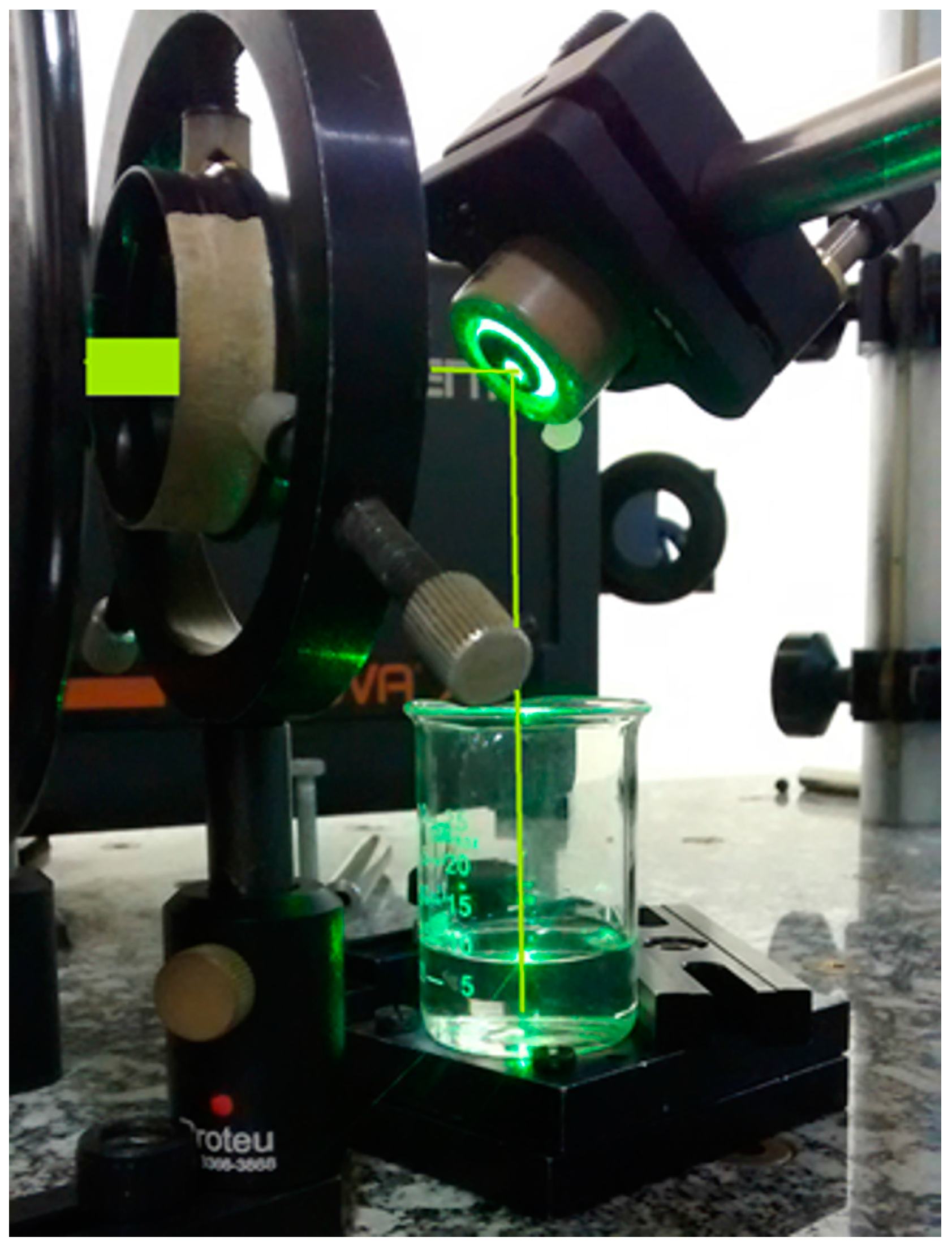
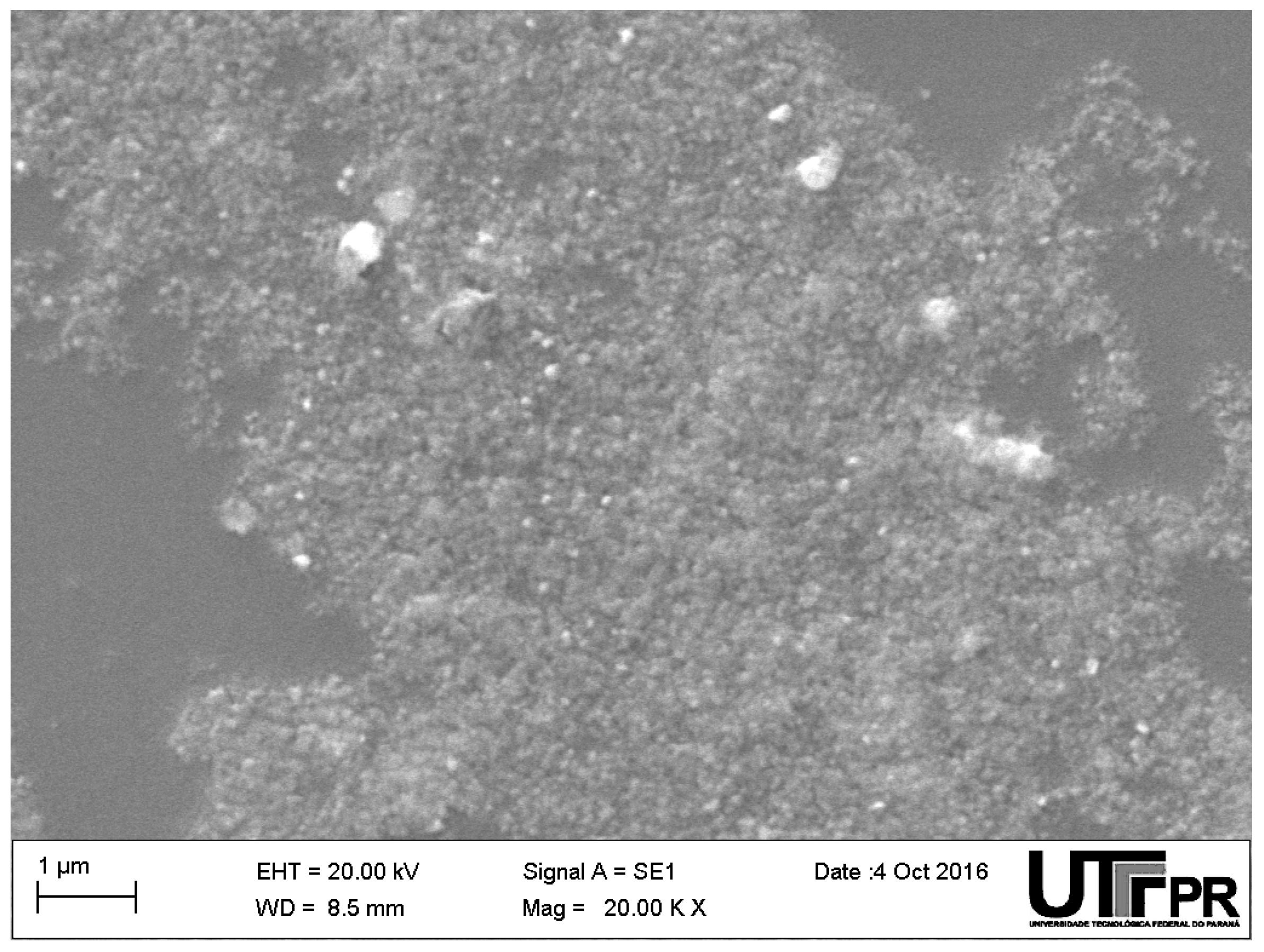
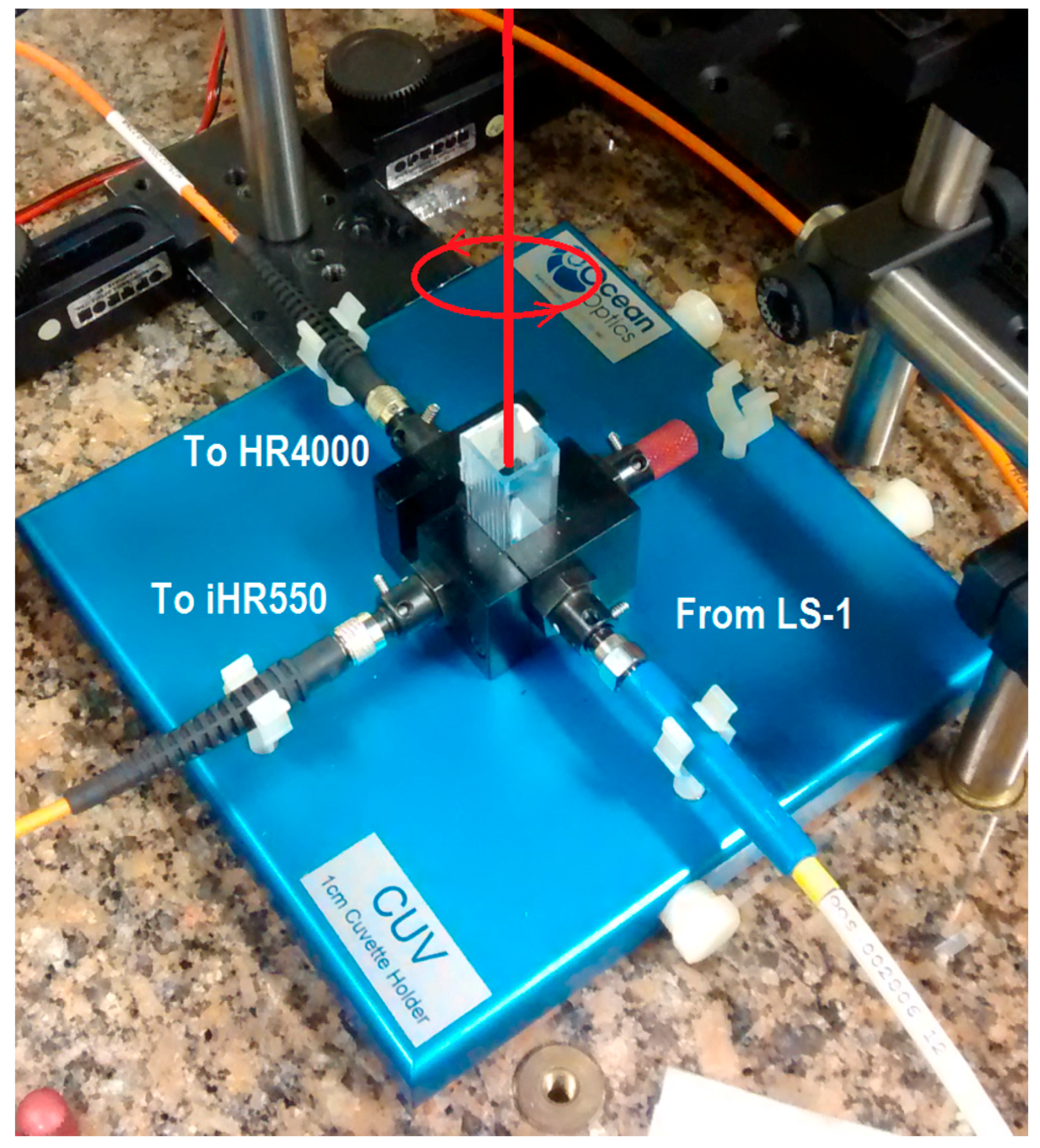
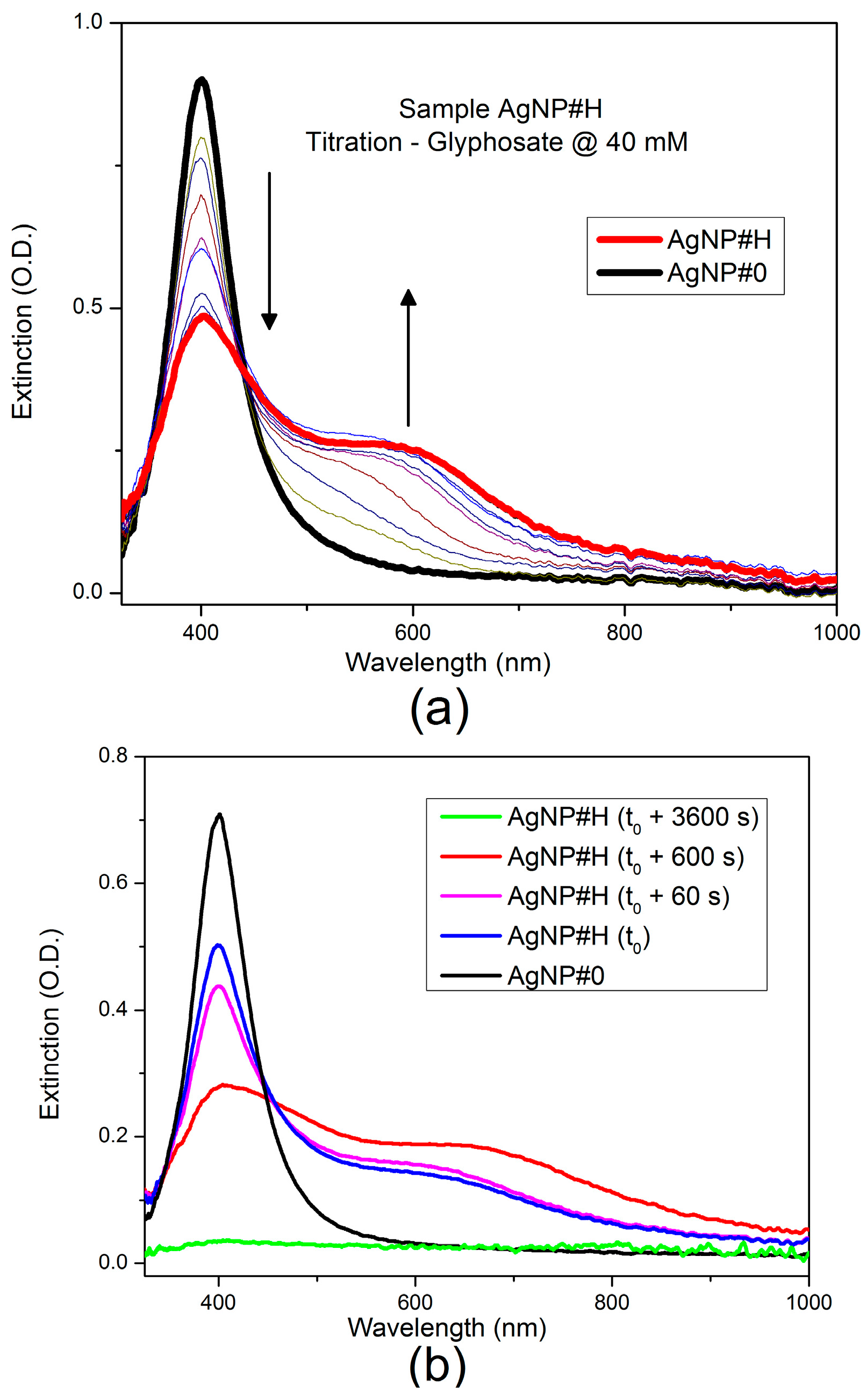
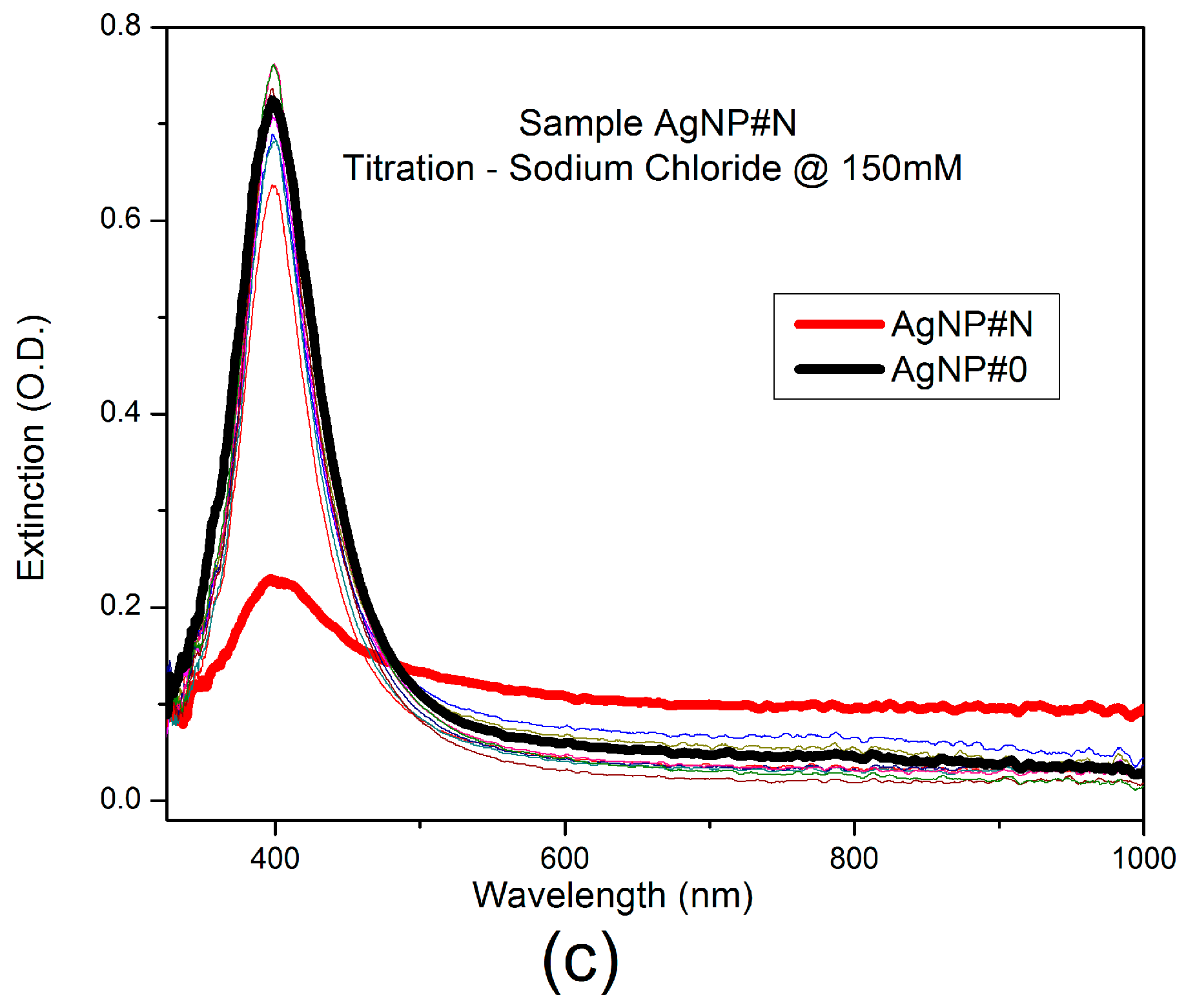
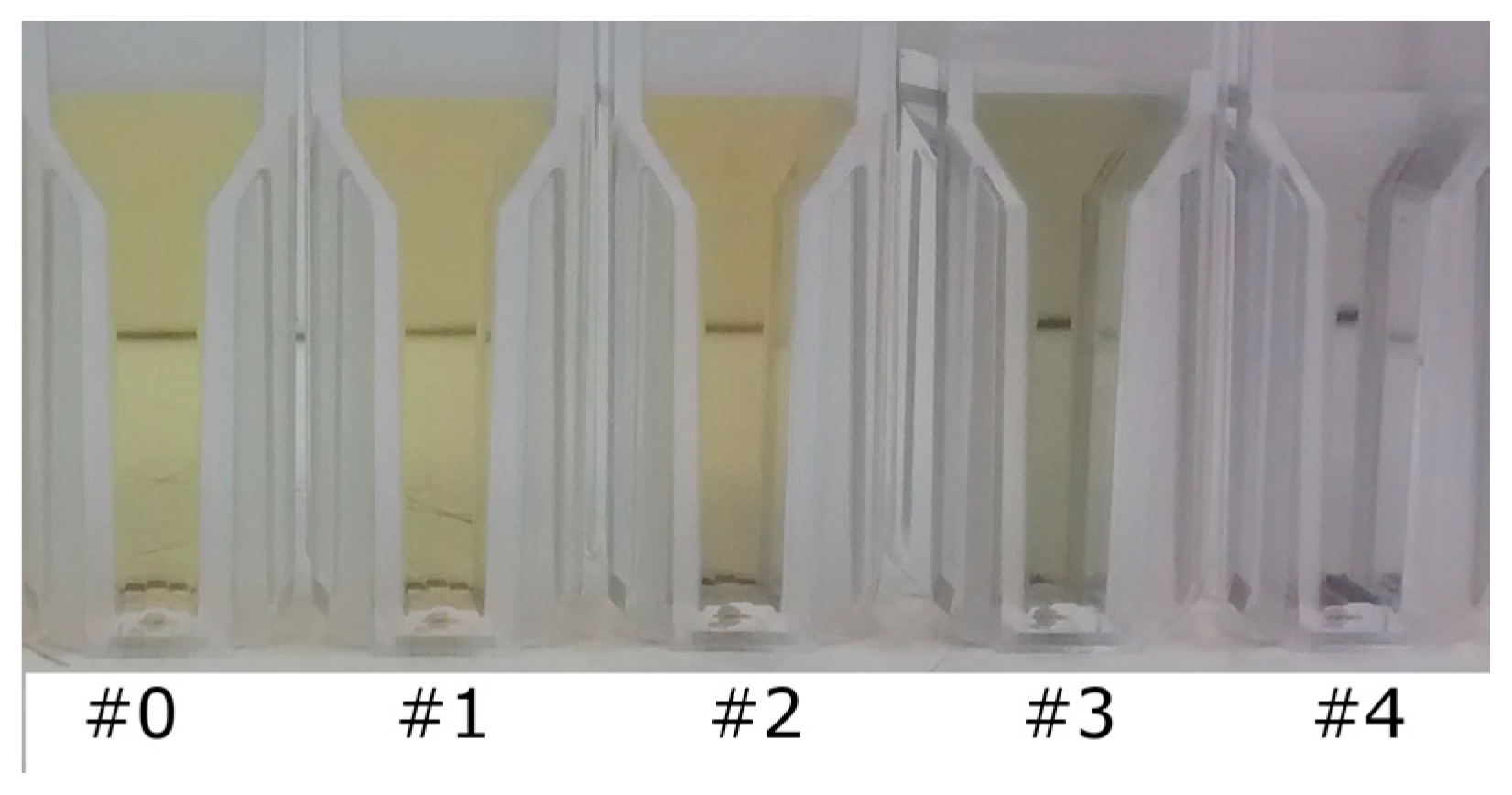
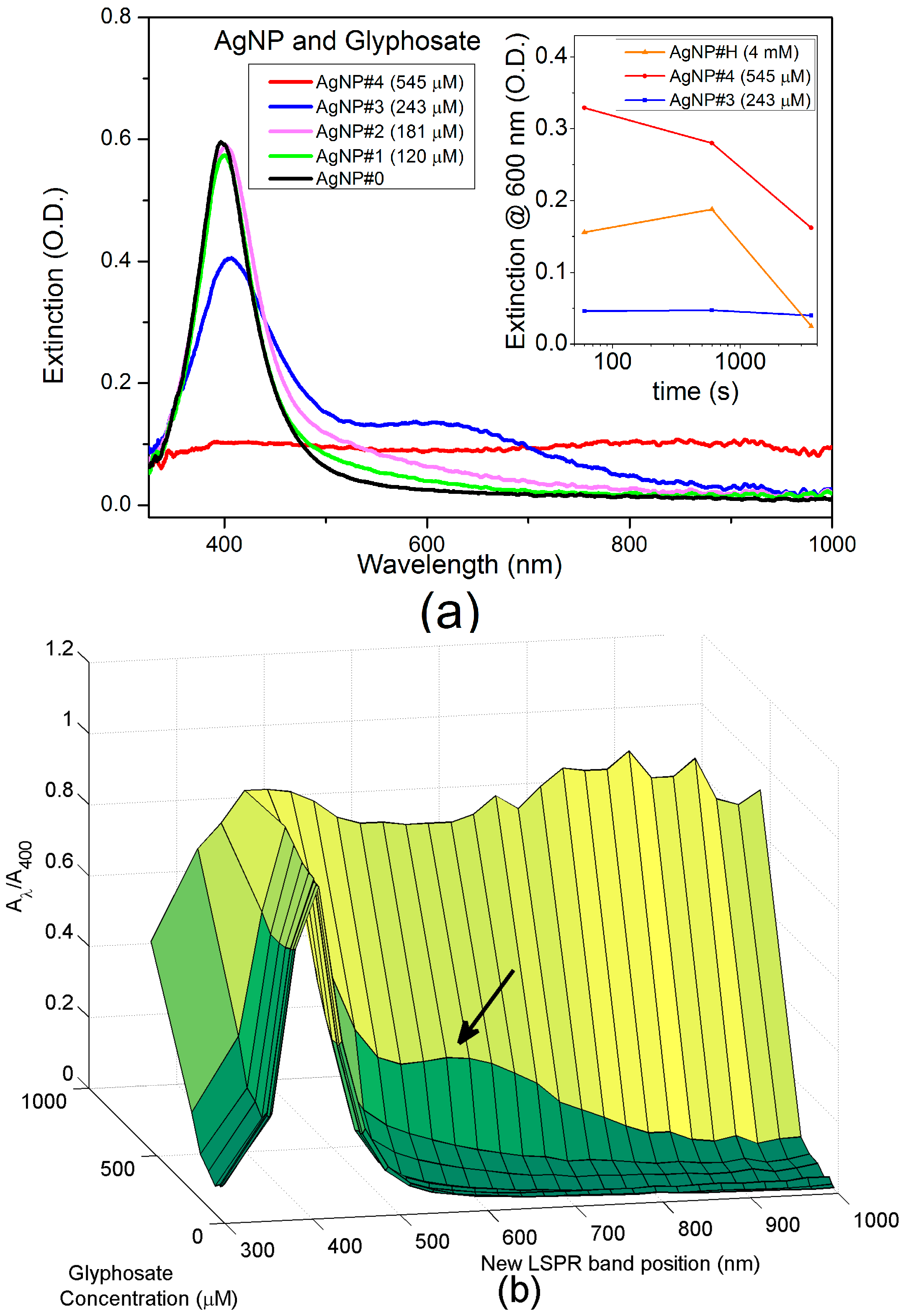
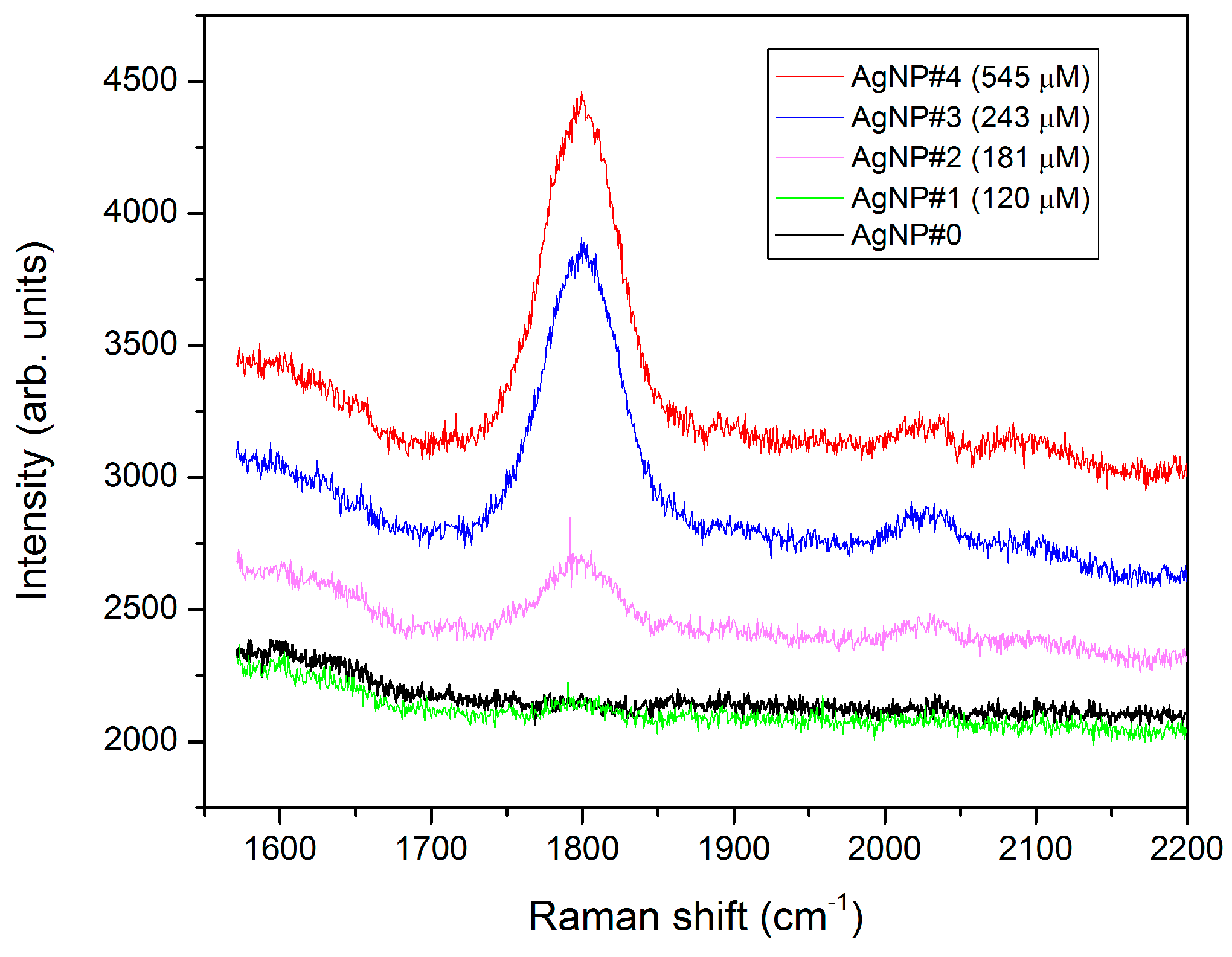
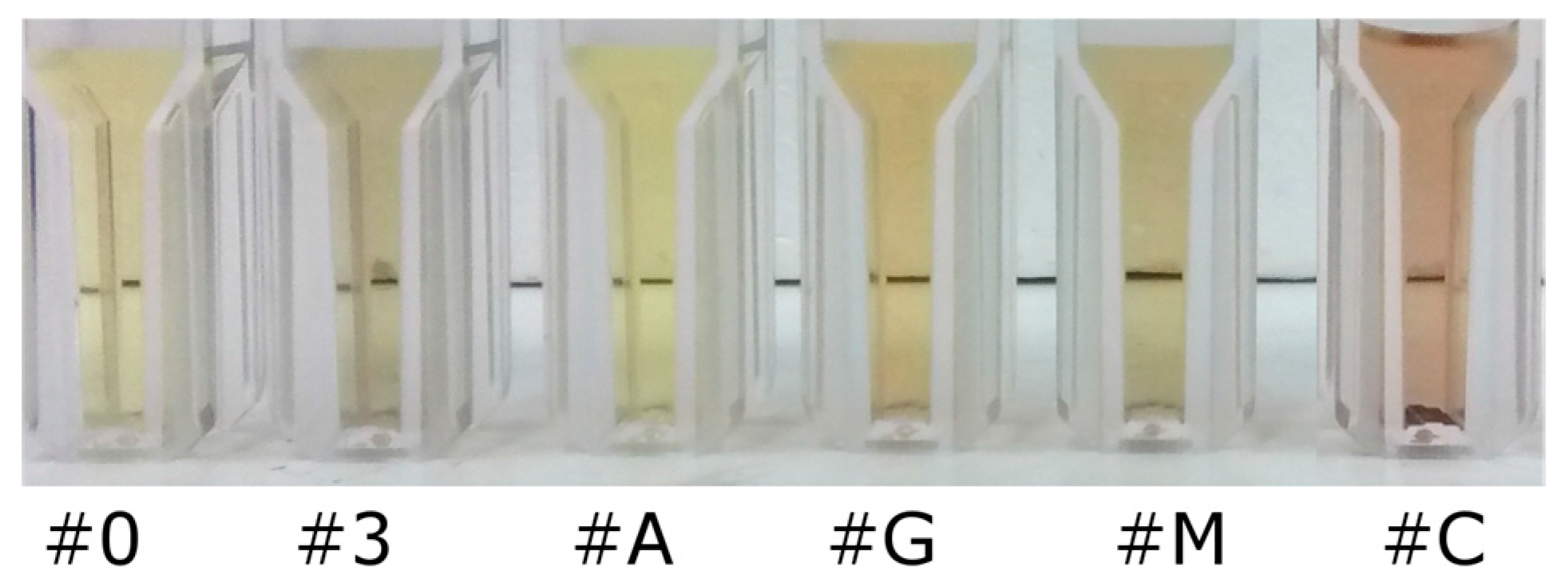
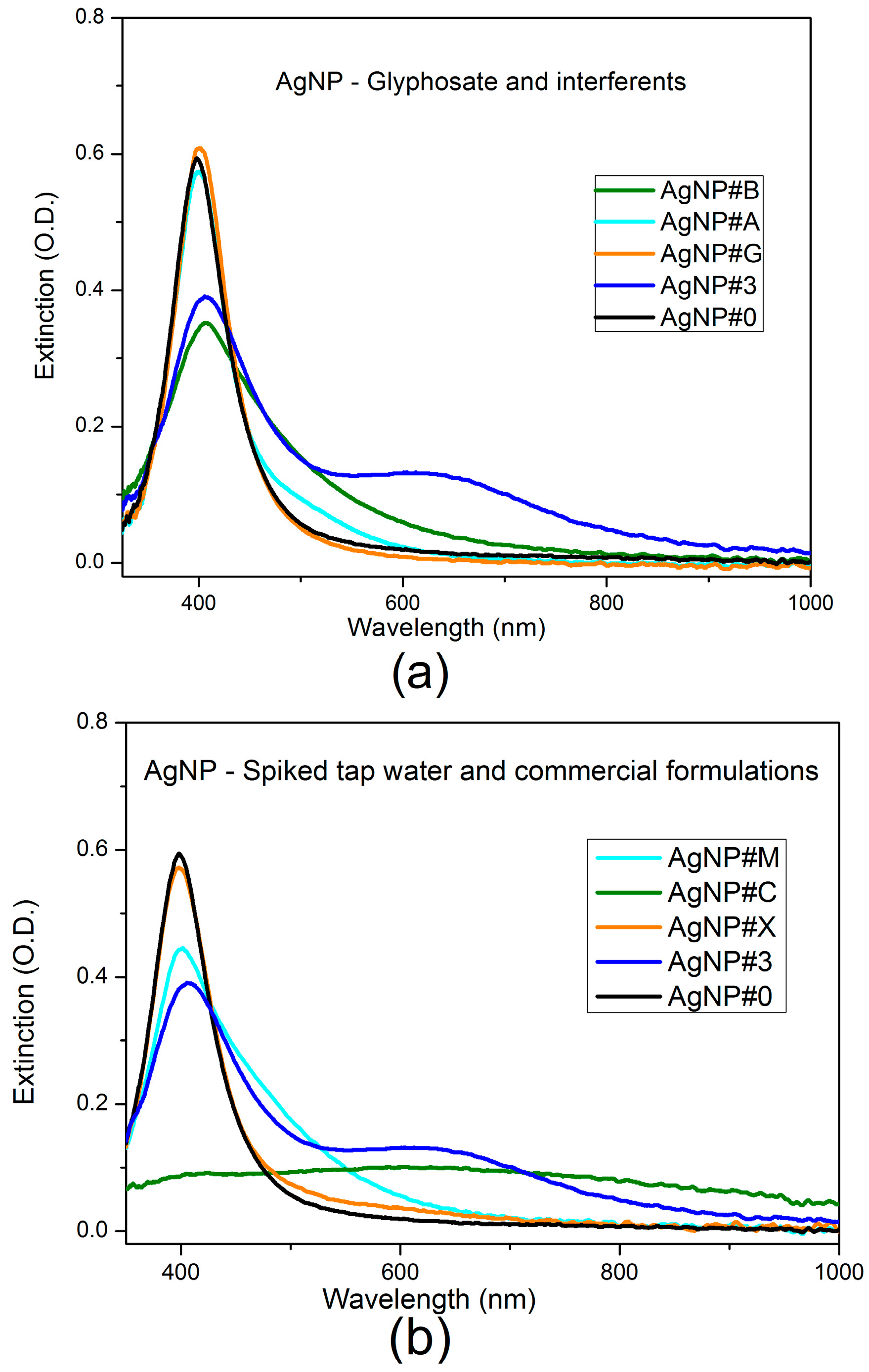
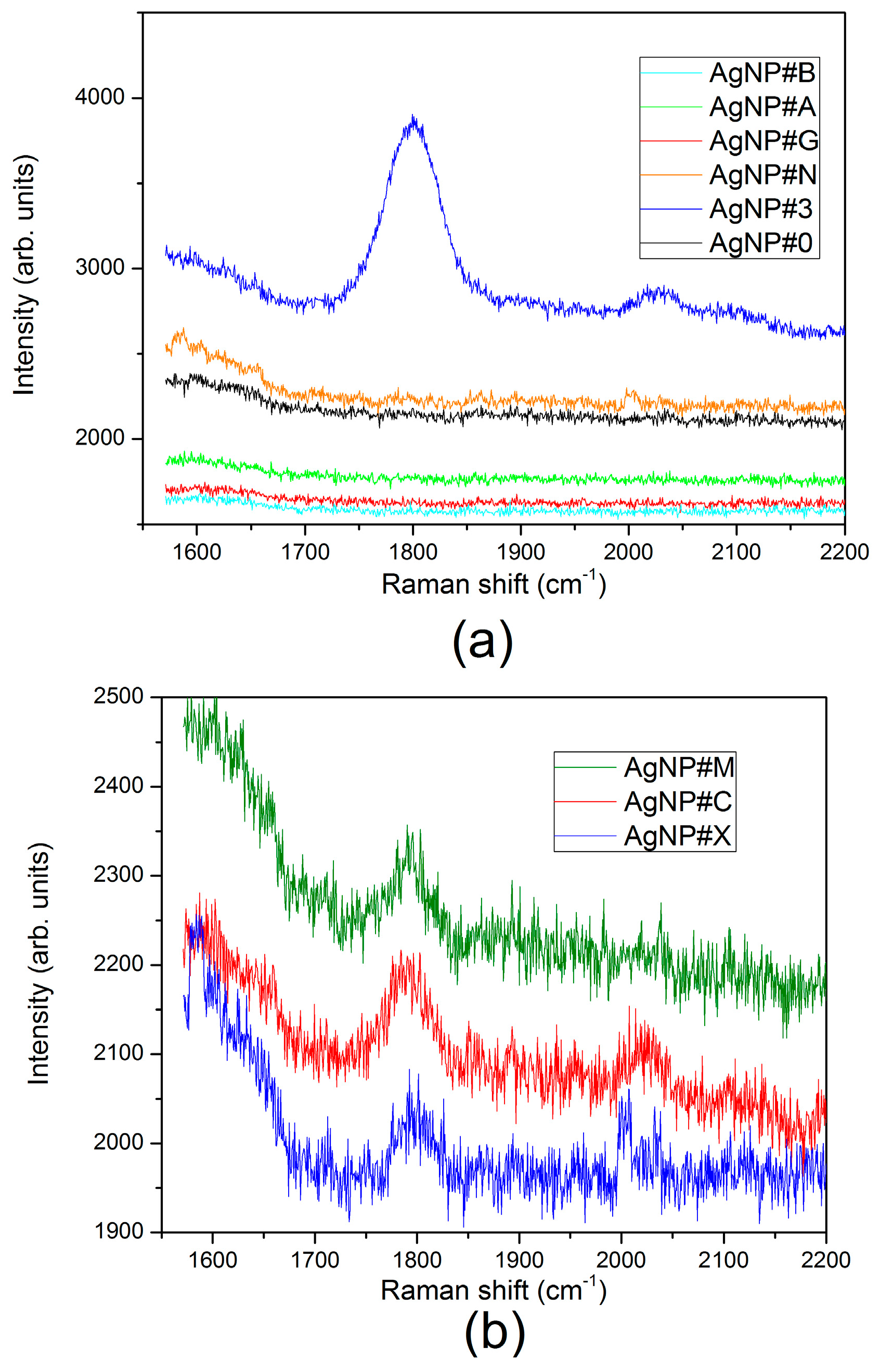
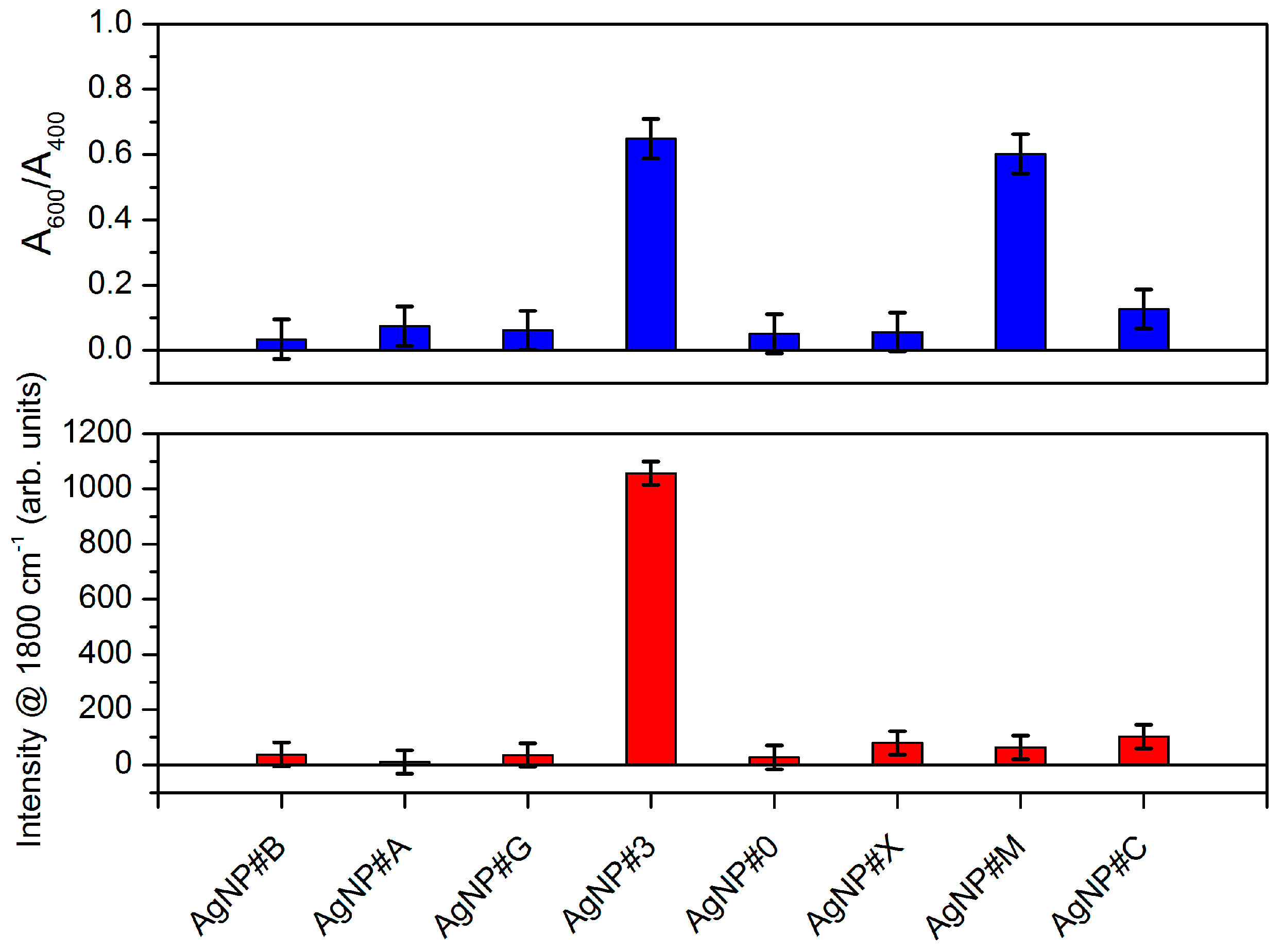
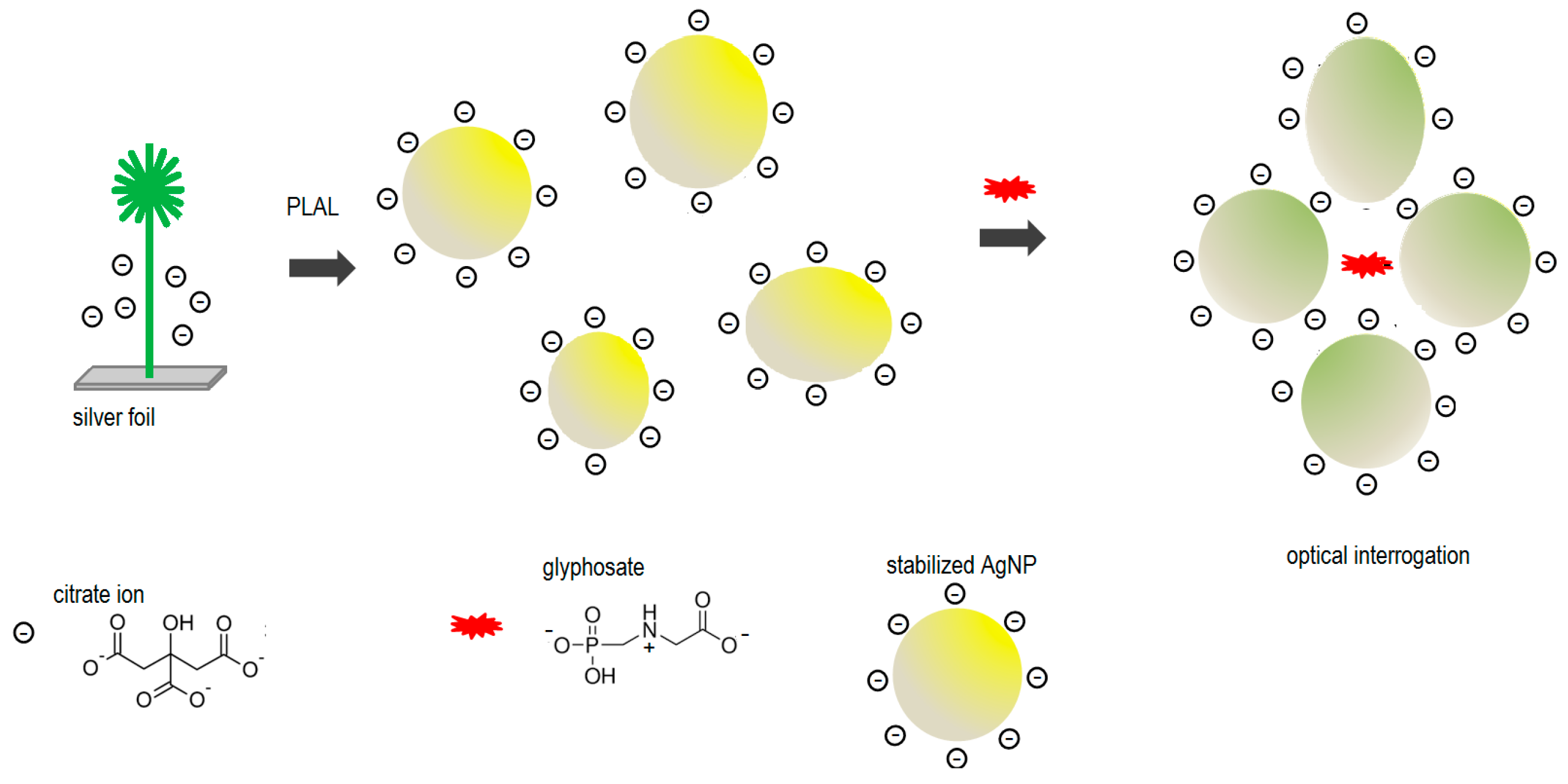
| Sample | Concentration (µM) | Analyte |
|---|---|---|
| AgNP#0 | 0 | - |
| AgNP#1 | 120 | Glyphosate |
| AgNP#2 | 181 | Glyphosate |
| AgNP#3 | 243 | Glyphosate |
| AgNP#4 | 545 | Glyphosate |
| AgNP#H | 4000 | Glyphosate |
| AgNP#N | 4000 | Sodium chloride |
| AgNP#A | 243 | AMPA |
| AgNP#G | 243 | Glufosinate-ammonium |
| AgNP#M | 300 1 | Commercial formulation 1 |
| AgNP#C | 300 1 | Commercial formulation 2 |
| AgNP#B | 0 | Tap water |
| AgNP#X | 243 | Tap water with glyphosate |
© 2017 by the authors. Licensee MDPI, Basel, Switzerland. This article is an open access article distributed under the terms and conditions of the Creative Commons Attribution (CC BY) license (http://creativecommons.org/licenses/by/4.0/).
Share and Cite
De Góes, R.E.; Muller, M.; Fabris, J.L. Spectroscopic Detection of Glyphosate in Water Assisted by Laser-Ablated Silver Nanoparticles. Sensors 2017, 17, 954. https://doi.org/10.3390/s17050954
De Góes RE, Muller M, Fabris JL. Spectroscopic Detection of Glyphosate in Water Assisted by Laser-Ablated Silver Nanoparticles. Sensors. 2017; 17(5):954. https://doi.org/10.3390/s17050954
Chicago/Turabian StyleDe Góes, Rafael Eleodoro, Marcia Muller, and José Luís Fabris. 2017. "Spectroscopic Detection of Glyphosate in Water Assisted by Laser-Ablated Silver Nanoparticles" Sensors 17, no. 5: 954. https://doi.org/10.3390/s17050954






